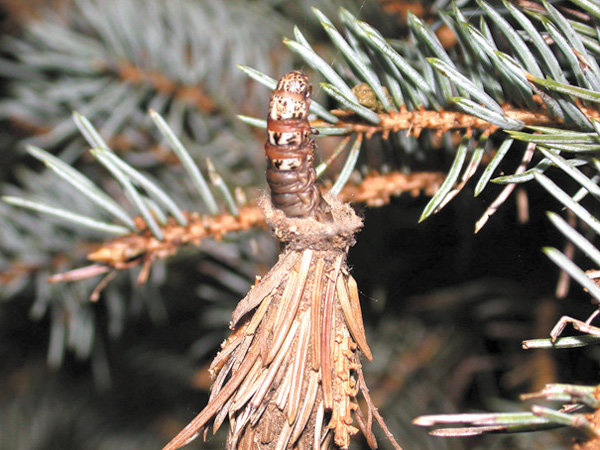Watch your shrubs and trees Bad bagworms


During July and August, bagworms may defoliate arborvitae, junipers and other trees and shrubs. Bagworms are caterpillars that live inside spindle-shaped bags which they construct to protect themselves against birds and other enemies.
By STEPHANIE HUGHES
OSU Ext. Master Gardener Volunteer
Many people have never even noticed bagworms, or, if they have, they may have thought they were pinecones.
Gardeners are noticing them now due to signs of infestation on coniferous trees.
Bagworms (Thyridopteryx ephemeraeformis) are a type of moth that can plague many conifers, as well as deciduous trees and shrubs. They begin a lifecycle here in the Valley in June.
They can be carried by wind, crawl, or even be carried by birds. They attach themselves by a thread of silk and build a small conical bag that is attached to a limb or a leaf. The bag looks like an upside-down ice cream cone made up of plant debris.
As the larvae eat new growth of the host plant, they molt and grow larger. By midsummer, they can grow up to an inch long.
As fall comes, they have gorged themselves on their host trees and close the end of the bag, pupating for four weeks. The males transform into clear-winged moths with black hairy bodies and feathery antennae. The females stay maggot-like inside their bags. They release a mating pheromone that draws the male.
After mating, females produce 500 to 1,000 eggs, then die. The eggs overwinter in the bag until spring, where the cycle begins anew.
The bag is easily identified as it is made up of leaf litter, sticks, and has a characteristic ovoid shape, up to two inches long.
Visible damage to the plant is brown spots on the tops of leaves as the new caterpillars begin to feed.
Older ones strip evergreens of needles and consume whole leaves of deciduous species.
Many times their presence is not detected until either bags or extensive stripping is seen.
Conifers are the preferred host, but many deciduous trees are also affected.
Conifers do not regrow needles, so if they are severely stripped of needles, the tree may perish.
Deciduous trees can regrow leaves during the season.
So, how can you control them? Sometimes, nature lends a hand. Some species of birds tear the bags and prey on the worms. Wasps and parasitoids prey on them.
There are effective insecticides, but be sure to always read and follow the label.
In the fall, winter and even early spring, the best way to deal with bagworms is to inspect your plants, pick off any bags before eggs can hatch, and smash or immerse them in hot soapy water.
Any time you are walking in your yard, it is a good idea to look at your plants. Inspect them for problems and issues, so they cannot take over.
For more details on these insects, visit http://go.osu.edu/bagworm.
 43
43
